Best Microsoft App for Writing a College Essay
We're here to offer the whole list of text summarizers in this article. Every tool has a strong algorithm so you won't have to proofread a lot in order to make the summary look hand-written. The usage of such websites can be productive for your studying as long as you can focus on more important tasks and leave this routine work to online tools.
In this blog post, you'll also find tips on successful summarizing and proofreading. These are basic skills that you will need for many assignments. To summarize text better, you'll need to read it critically, spot the main idea, underline the essential points, and so on. As for proofreading, this skill is useful not only to students but also to professional writers.
⚙️ 12 Best Summarizing Tools
To summarize a text, a paragraph or even an essay, you can find a lot of tools online. Here we'll list some of these, including those that allow choose the percent of similarity and define the length of the text you'll get.
If you're asked to summarize some article or paragraph in your own words, one of these summary makers can become significant for getting fast results. Their user-friendly design and accurate algorithms play an important role in the summary development.
1. Summarize Bot
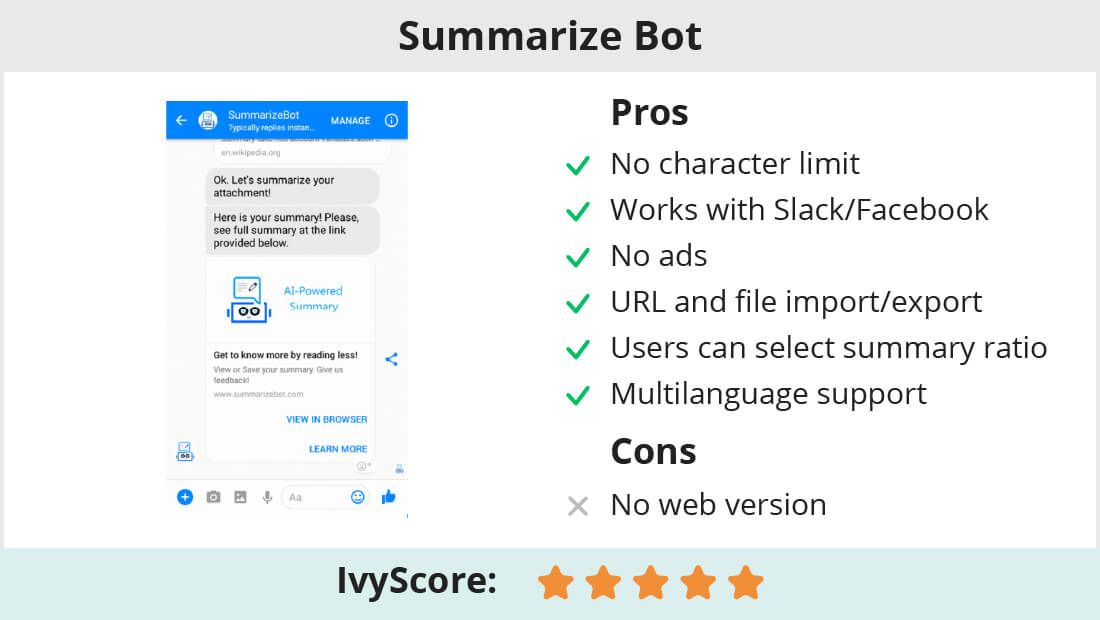
Summarize Bot is an easy-to-use and ad-free software for fast and accurate summary creation in our list. With its help, you can save your time for research by compressing texts. The summary maker shows the reading time, which it saves for you, and other useful statistics. To summarize any text, you should only send the message in Facebook or add the bot to Slack. The app works with various file types: including PDF, mp3, DOC, TXT, jpg, etc., and supports almost every language.
The only drawback is the absence of web version. If you don't have a Facebook account and don't want to install Slack, you won't be able to enjoy this app's features.
2. SMMRY
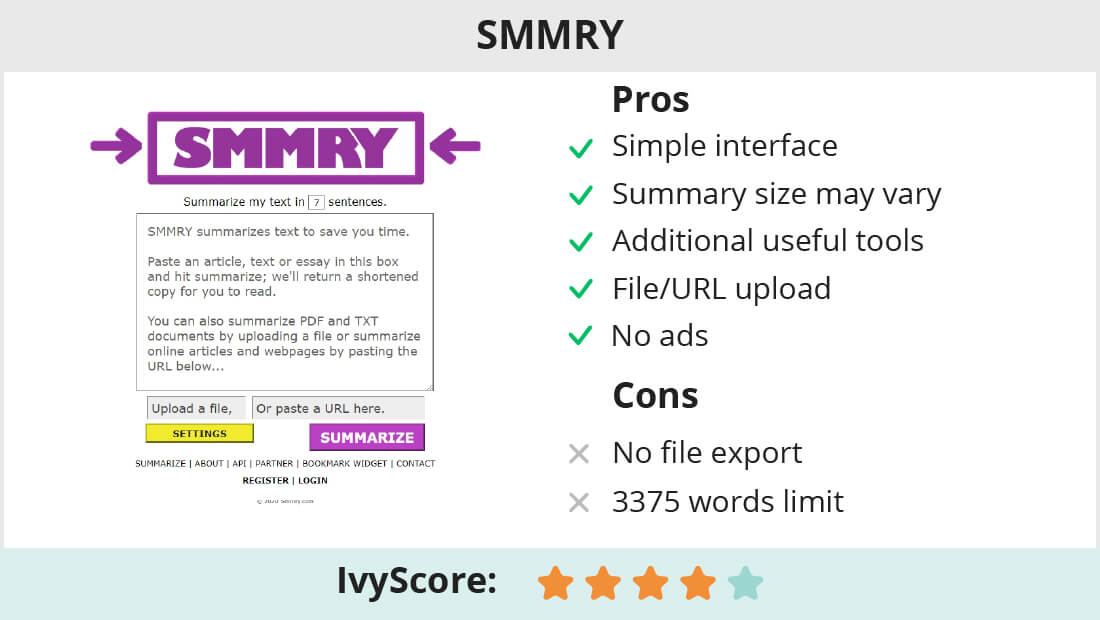
SMMRY has everything you need for a perfect summary—easy to use design, lots of features, and advanced settings (URL usage). If you look for a web service that changes the wording, this one would never disappoint you.
SMMRY allows you to summarize the text not only by copy-pasting but also with the file uploading or URL inserting. The last one is especially interesting. With this option, you don't have to edit an article in any way. Just put the URL into the field and get the result. The tool is ad-free and doesn't require registration.
3. Tools4Noobs summarize tool
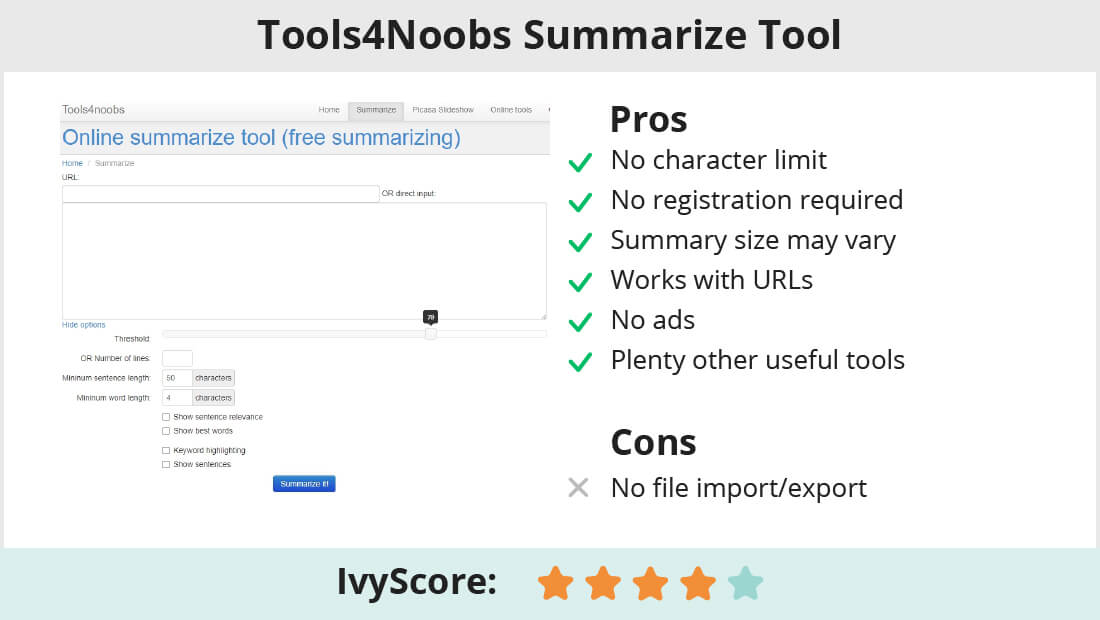
Tools4Noobs summarize tool is a comfortable article summarizer with a wide range of settings. You can use Threshold function to limit the number of sentences based on relevance or reduce the summary to a specific length. Here it is also possible to see the main keywords or highlight them in the text. The software works with texts you insert or you can give it URL you want to summarize.
The website is ad-free and if you like it, you can support its developers by donating some money. Also, there are plenty of other useful tools and calculators for students.
4. Split Brain Summary Tool
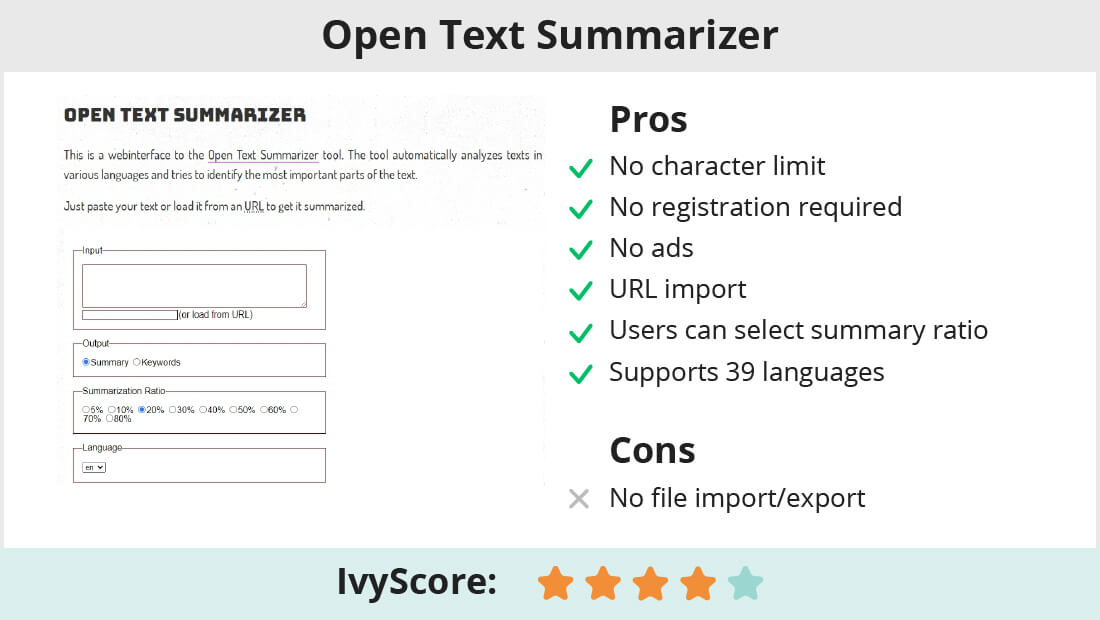
Split Brain Summary Tool is a helpful app to summarize texts and articles in a great variety of languages. You can choose one of thirty-nine languages to make a couple of sentences on your article!
The difference in summaries also can be produced by the summarization ratio. You can change it from 5% to 80% controlling the density of paraphrasing.
There's also a possibility to insert an URL instead of the text. However, there is no option to import a file or export the result to PDF, DOC, or any other popular format. The website is ad-free and contains lots of other useful tools for students.
5. TextSummarization

TextSummarization tool allows you to put the text into the field or give a link to a source where your article is posted. Then, set the number of sentences you want to have in your text. This summary maker analyzes your nonfiction text and extracts the exact number of sentences you're aiming at.
The website is free, however, it contains ads, so make sure you turned on the ad-blocker. Also, the tool doesn't let its users import files or export the result to TXT, PDF, or Doc for other popular formats.
6. Text Compactor
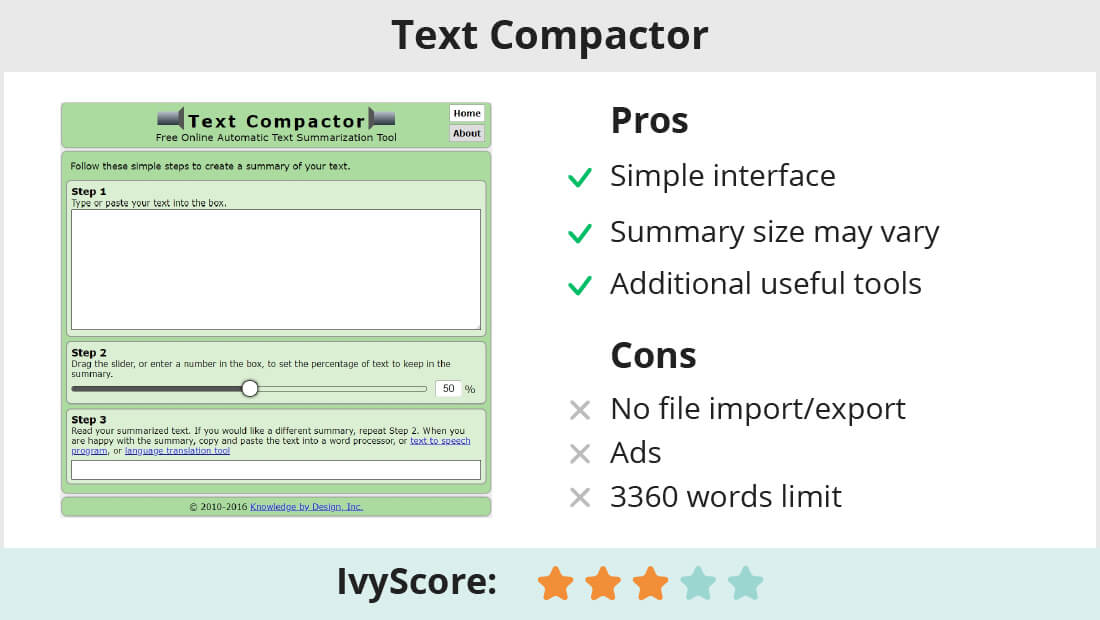
Text Compactor is a free summarizing tool where you have to set the percentage of text to keep in summary. The website is ad-free and doesn't require registration. Its users can choose the output result within the range of 1-100%. If you are not satisfied with the result, change the percentage and try again. Although the tool is easy-to-use, it doesn't allow users to import files or URLs and save the result into the popular file types.
7. Resoomer
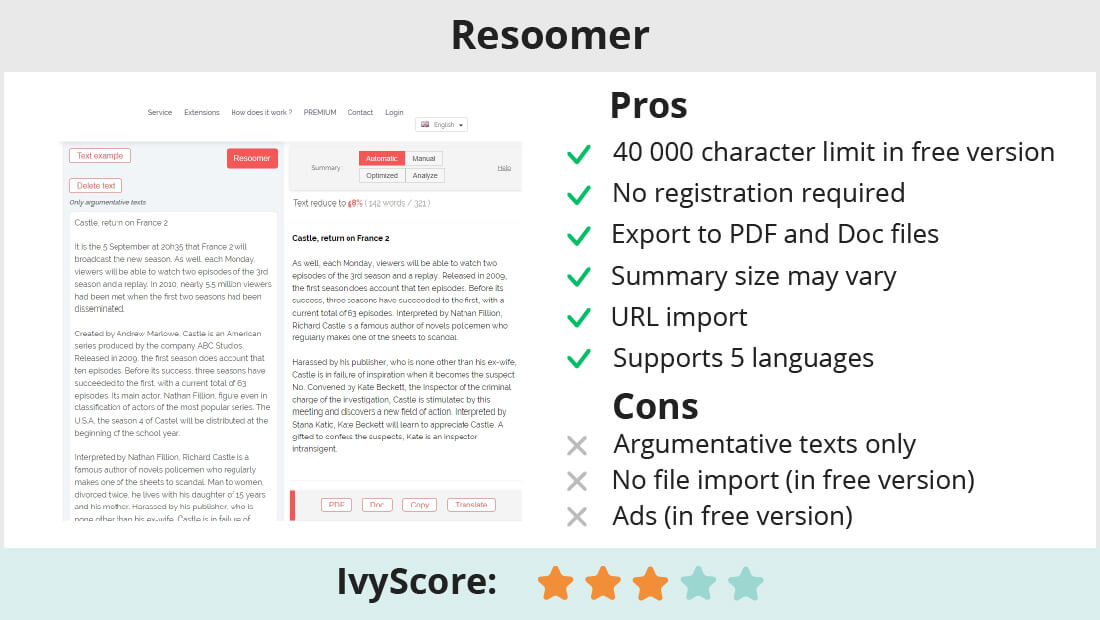
Resoomer is another paraphrasing and summarizing tool that works with several languages. You're free to use the app in English, French, German, Italian, and Spanish.
This online tool may be considered as one of the best text summarizers in IvyPanda ranking, because it allows performing many custom settings. For example, you can click to Manual and set the size of the summary (in percent or words). You can also set the number of keywords for the tool to focus on.
Among its drawbacks, we would mention that the software works only with argumentative texts and won't reword other types correctly. Also, free version contains lots of ads and does not allow its users to import files. The premium subscription costs 4.90€ per month or 39.90€/year.
8. Summarizer
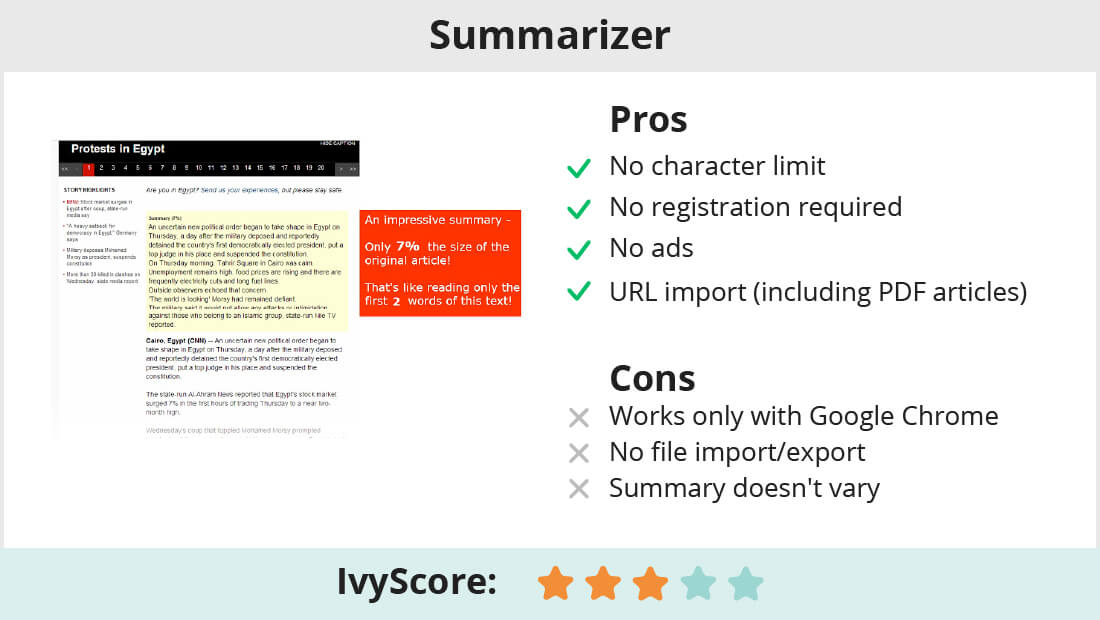
Summarizer is another good way to summarize any article you read online. This simple Chrome extension will provide you with a summary within a couple of clicks. Install the add-on, open the article or select the piece of text you want to summarize and click the button "Summarize".
The software processes various texts in your browser, including long PDF articles. The result of summarizing has only 7% of the original article. This app is great for all who don't want to read long publications. However, it doesn't allow you to import file or download the result.
9. Simplifly
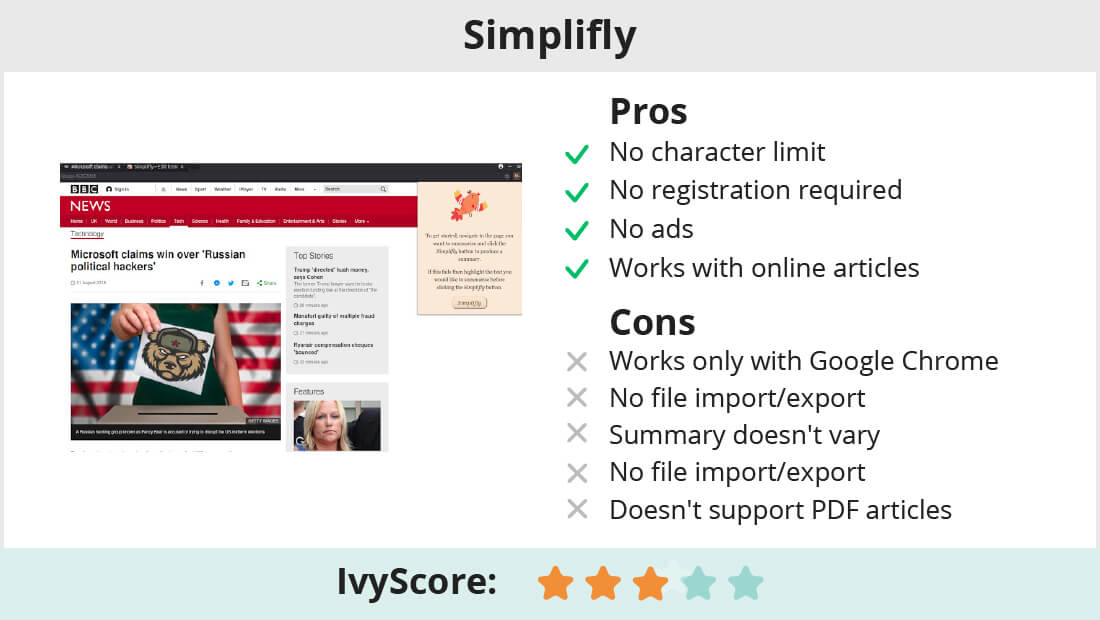
Simplifly is one more way to summarize a scientific article for your research. The rules are the same – install the free Chrome extension, open the website, and get a summary.
The software is ad-free, doesn't require registration, and has no character limits. It works great with online articles and news websites; however, it doesn't support PDF articles and scientific journals. You can't summarize doc or any other file, vary or download the result.
10. Autosummarizer
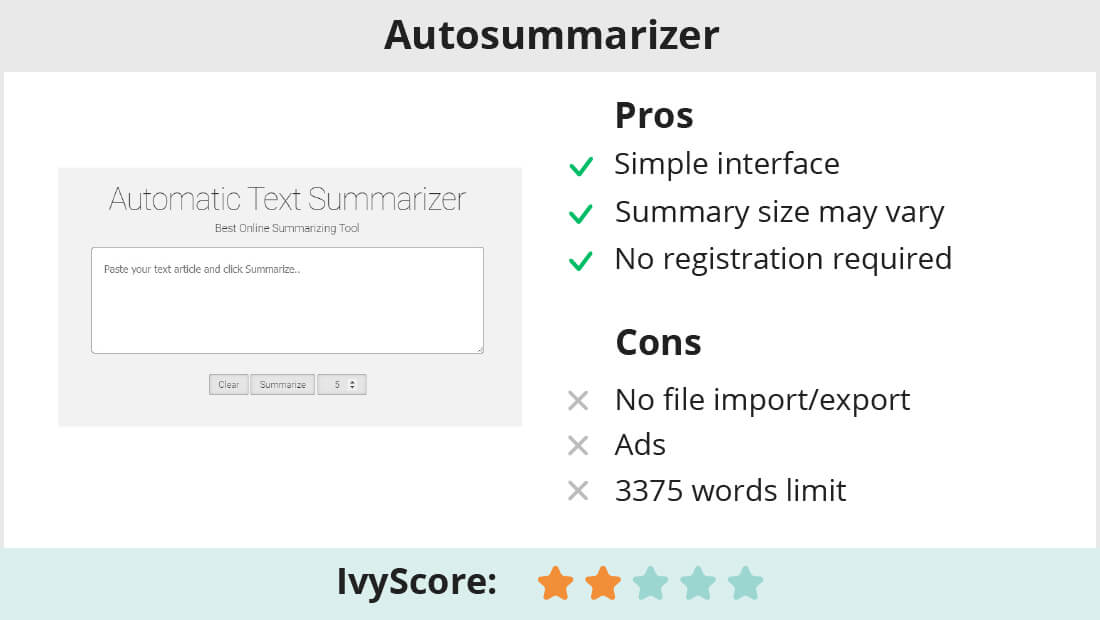
Autosummarizer is a great tool for those in hurry. It has a minimum of functions and produces short summaries. Users can set up from 5 to 10 sentences of the output result. The tool is free and requires no registration.
However, it doesn't allow you to summarize files or web pages. Also, you should have ad-blocker to keep yourself away from ads on this website.
11. AppZaza Article Summarizer
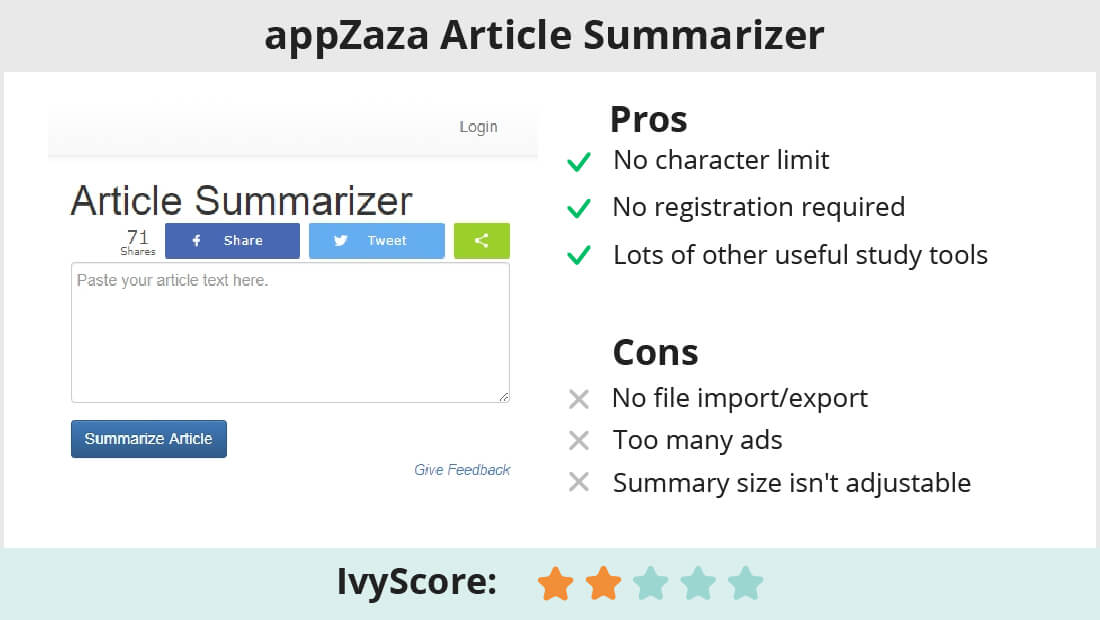
AappZaza Article Summarizer is one more simple summary creator for your academic and professional needs. The software is free and doesn't require registration. However, you might be distracted with lots of ads around the tool.
The app is simple and to reword a text, you need only type it or paste the article and click "Summarize Article" button. To get better results, try to summarize only well-structured documents. The software does not support import files or export the summary to any popular format.
Also, the appZaza website contains a lot of useful tools and apps that may come in handy for every student.
12. Summary Generator
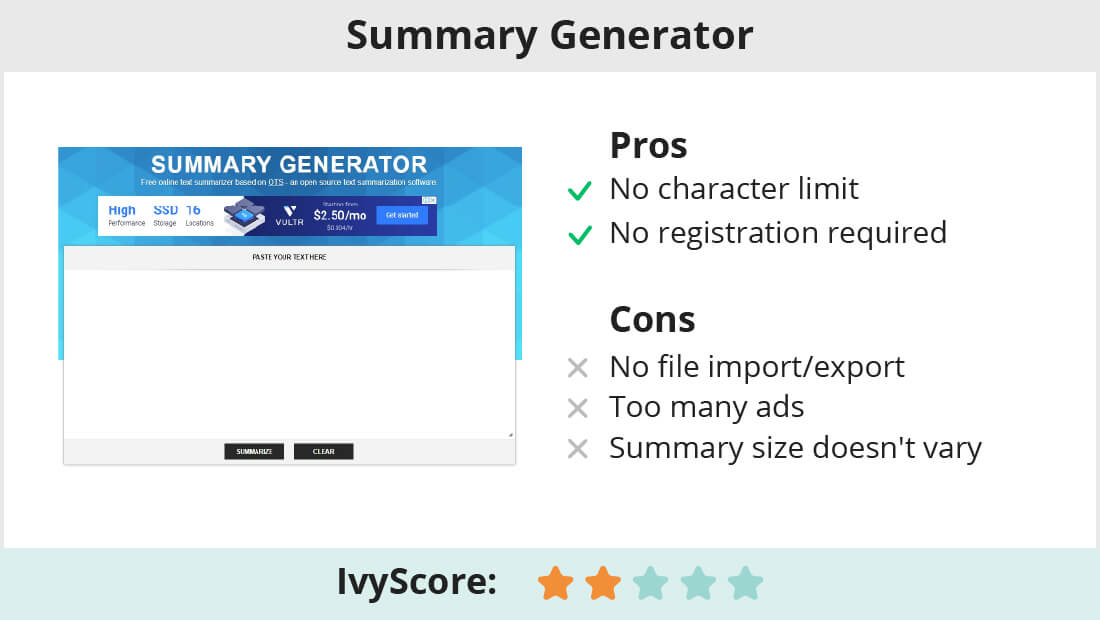
The last article and essay Summary Generator in our list which can be helpful for your experience in college or university. This is free open software everyone can use.
The tool has only two buttons—one to summarize the document and the other to clear the field. With this software, you'll get a brief summary based on your text. You don't have to register there to get your document shortened.
Speaking about drawbacks of the website, we would mention too many ads and no options to summarize a URL or document, set up the length of the result and export it to the popular file types.
These were the best online summarizing tools to deal with the task effectively. We hope some of them became your favorite summarizers, and you'll use them often in the future.
🤔 How to Summarize an Article without Plagiarizing?
Of course, there are times when you can't depend on online tools. For example, you may be restricted to use them in a class or maybe you have to highlight some specific paragraphs and customizing the tool's settings would take more time and efforts than summary writing itself.
In this chapter, you'll learn to summarize a long article, essay, research paper, report, or a book chapter with the help of helpful tips, a logical approach, and a little bit of creativity.
Here are some methods to let you create a fantastic summary.
- Know your goal. To choose the right route to your goal, you need to understand it perfectly. Why should you summarize the text? What is its style: scientific or publicistic? Who is the author? Where was the article published? There are many significant questions that can help to adapt your text better. Develop a short interview to use during the summary writing. Include all the important information on where you need to post the text and for what purpose.
- Thorough reading. To systemize your thoughts about the text, it's significant to investigate it in detail. Read the text two or more times to grasp the basic ideas of the article and understand its goals and motives.
Give yourself all the time you need to process the text. Often we need a couple of hours to extract the right results from the study or learn to paraphrase the text properly. - Highlight the main idea. When writing a summary, you bear a responsibility for the author. Not only you have to extract the significant idea of the text but to paraphrase it correctly. It's important not to misrepresent any of the author's conclusions in your summary. That's why you should find the main idea and make sure, you can paraphrase it without a loss of meaning.
If possible, read a couple of professional reviews of a targeted book chapter or article. It can help you to analyze the text better. - Mark the arguments. The process of summarizing is always easier if you have a marker to highlight important details in the text. If you don't have a printed text, there's always Microsoft Word to use a highlight tool on the paper.
Try to mark all arguments, statistics, and facts in the text to represent them in your summary. This information will turn into key elements of the summary you'll create, so keep attention on what you highlight exactly. - Take care of plagiarism. Before you start writing, learn what percent of originality should you aim at. Various projects have different requirements. And they determine how many efforts you should put into writing to get a perfect summary your teacher will like.
Depending on the percent of originality, build a plan for your short text. Allow yourself copy as much information as allowed to save your time. - Build a structure. With the help of key elements, which you've highlighted in the text, it's possible to create a powerful structure including all the interesting facts and arguments.
Develop an outline according to a basic structure – introduction, body, and conclusion. Even if your summary is extremely short, the main idea should sound in both the first and last sentences. - Write a draft. If you're not a professional writer, it can be extremely difficult to develop a text with the correct word count on the first try. We advise you to develop a general text firstly – include all the information without controlling the number of sentences.
- Cut out the unnecessary parts. On this step, you should edit the draft and eliminate the unnecessary parts. Keep in mind, the number of sentences your summary must contain. Make sure the main point is fully represented in the text. You can cut out any sentence except those concluding the significant arguments.
- Proofread your summary. We recommend making a thorough proofread of your summary. Here are the main aspects to check in your text:
- Wordiness – you should delete unnecessary words, which make it difficult to understand the text
- Common mistakes – mistakes made in academic papers are basically the same, so it's helpful to have an article like this one when you're proofreading
- Appropriate terminology – for each topic, there's a list of the terminology you can use
- Facts and statistics – you can accidently write a wrong year or percent, make sure to avoid these mistakes
- Quotes – every quote should be written correctly and have a link to its source.
Then, read the following chapter! We've collected a couple of tips to help you with academic editing.
📝 How to Proofread Your Summary?
Now, when you know how to summarize an article, it's time to edit your text whether it's your own writing or a summary generator's results.
In this chapter, you'll see the basic ways to proofread any type of text: academic paper (essay, research paper, etc.), article, letter, book's chapter, and so on.
- Proofread your summary. Are there times when you can't remember an appropriate synonym? Then you should use Thesaurus and analogous services from time to time.
They can expand your vocabulary a lot and help to find the right words even in the most challenging situations. - Pay attention to easily confused words. It's especially significant if you edit a nonfiction text – there's a number of words people often confuse without even realizing. English Oxford Living Dictionaries have a list of these word pairs so you won't miss any.
- Proofread one type of mistakes at a time. To edit a paper properly don't split your attention to grammar and punctuation—this way you can miss dozens of mistakes. To get more accurate results, read the first time to edit the style, the second to eliminate grammar mistakes, and the third to proofread punctuation. Take as many times as you need to concentrate on each type.
- Take a rest from your paper. If you use an online summarizing tool, you can skip this step. But if you've been writing a paper for several hours and now trying to edit it without taking a break, it may be a bad idea. Why? Because without a fresh pair of eyes there's a great possibility not to spot even obvious mistakes.
Give yourself some time to slightly forget the text—go for a walk or call a friend, and then return to work as a new person. - Hire a proofreader. If you need to get perfect results, think about hiring a professional. Skills and qualification, which they have, guarantee a perfect text without any mistakes or style issues. Once you find a proofreader, you can optimize your work perfectly.
Search for specialists on freelance websites like UpWork — it's comfortable and safe to use. Of course, there's one flaw you should think about—hiring a pro is expensive. So, everyone should decide on their own whether they need to spend this money or not. - Switch your paper with a friend. If you can't afford a professional editor, there's a less expensive option—ask a friend to look through your paper and proofread theirs in return.
Make sure, you both make manual editing, not just check it with Microsoft Office or analogous software. Although there are great grammar tools, they still can't spot many mistakes obvious to a human. - Use grammar checking tools. We recommend you not to depend on multiple grammar tools. But the assistance it can offer is irreplaceable. Start your proofreading by scanning your text with Grammarly or an analogous tool.
The service detects many types of errors including confusing words' pairs, punctuation, misspellings, wordiness, incorrect word order, unfinished sentences, and so on.
Of course, you should never correct the mistakes without thinking on every specific issue. Tools not only miss a lot of mistakes but they also can be wrong about your errors. - Read aloud. It's amazing how different the written text can sound when read aloud. If you practice this proofreading method, you know that many mistakes can be spotted if you actually pronounce the text.
Why does it happen? People understand information better if they perceive it with the help of different senses. You can use this trick even in learning— memorize the materials with the help of reading, listening, and speaking.
These tips are developed to help students proofread their papers easily. We hope this chapter and the post itself create a helpful guide on how to summarize an article.
Here you found the best summarizing tools, which are accessible online and completely free, and learned to summarize various texts and articles on your own.
Text Summarizing FAQs
📌 How to write an academic summary?
An academic summary is a broad overview of the source. To make an article summary, you need to put its main ideas into your own words. A summary shouldn't be extensive. Still, it takes time to write a perfect one. The key to success is reading the source thoroughly. You need to make sure that you understand the main ideas of the text very well.
📌 How to summarize without plagiarizing?
- Use your own words. Try to avoid paraphrasing the text sentence by sentence.
- Use special software to check your summary for plagiarism. There are many free plagiarism checkers to be found online.
- Do not forget that presenting other authors' ideas without any reference to them, even when done in your own words, is also plagiarism. Be sure to refer to the source when working on your text.
📌 How to summarize in your own words?
- Read the text thoroughly to make sure that you understand its main idea quite well.
- Write an introduction. Formulate there the main idea of the text. Articulate it very clearly, make a short statement.
- Put your source away and write the body of your summary without looking into it. If you feel that you've forgotten something important, go back to the source and reread the whole story. Then go on working on your summary.
📌 Which linguistic tools help in summarizing a text?
Automated tools that help in summarizing a text are called summary generators. There are plenty of free online text summarizers to be found on the web. The general principle of these tools is quite simple. You paste the text you need to summarize into a box, set the desired number of words, get your summary, and enjoy the results!
📌 What is the purpose of summarizing an essay?
The purpose of an essay summary is to present the most important points and arguments of a text. A good summary is short and logical. Imagine that you need to describe the author's intent to someone who has not read the essay. To make a good summary, you need to read the work thoroughly.
References
A Language Independent Algorithm for Single and Multiple Document Summarization: aclweb.org
4 of the Best Online Summarizer Tools to Shorten Text: maketecheasier
Summarizing: University of Toronto
5 Easy Summarizing Strategies for Students: ThoughtCo.
3 Advantages of Automatic Text Summarization: Ezine Articles
Comparative Study of Text Summarization Methods: Semantic Scholar
A Review on Automatic Text Summarization Approaches: Journal of Computer Science
How to Write a Summary: UTEP
How to Write a Summary: UW
Best Microsoft App for Writing a College Essay
Source: https://ivypanda.com/online-text-summarizer
0 Response to "Best Microsoft App for Writing a College Essay"
Post a Comment